Java基础之NIO
NIO简介:
Java NIO(New IO)是从Java 1.4版本开始引入的一个新的IO API,可以替代标准的Java IO API。NIO与原来的IO有同样的作用和目的,但是使用的方式完全不同,NIO支持面向缓冲区的、基于通道的IO操作。NIO将以更加高效的方式进行文件的读写操作。
NIO与IO的主要区别:

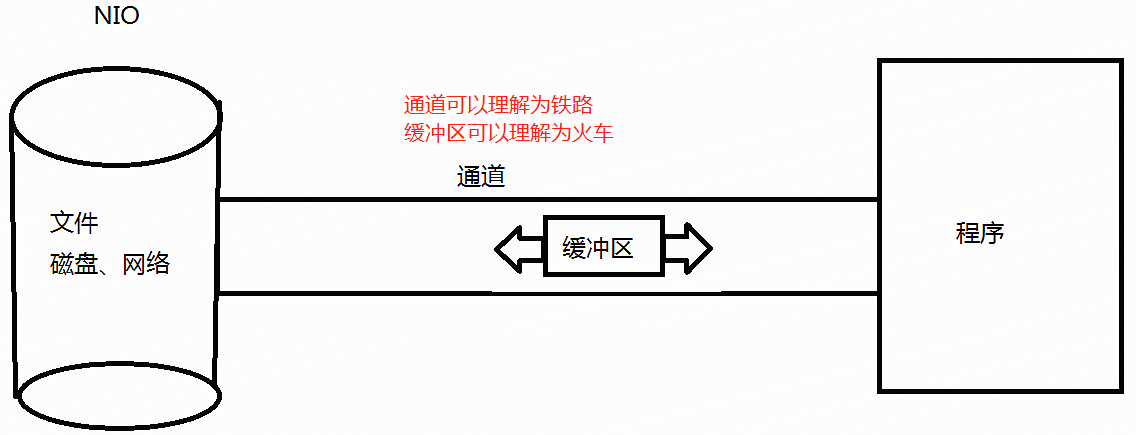
通道和缓冲区:
Java NIO系统的核心在于:通道(Channel)和缓冲区(Buffer)。通道表示打开到 IO 设备(例如:文件、套接字)的连接。若需要使用 NIO 系统,需要获取用于连接 IO 设备的通道以及用于容纳数据的缓冲区。然后操作缓冲区,对数据进行处理。简而言之,Channel 负责传输, Buffer 负责存储。
一、缓冲区(Buffer):
1、一个用于特定基本数据类型的容器。由 java.nio 包定义的,所有缓冲区都是 Buffer 抽象类的子类。Java NIO 中的 Buffer 主要用于与 NIO 通道进行交互,数据是从通道读入缓冲区,从缓冲区写入通道中的。
2、Buffer 就像一个数组,可以保存多个相同类型的数据。根据数据类型不同(boolean 除外) ,有以下 Buffer 常用子类:
ByteBuffer
CharBuffer
ShortBuffer
IntBuffer
LongBuffer
FloatBuffer
DoubleBuffer
上述 Buffer 类 他们都采用相似的方法进行管理数据,只是各自管理的数据类型不同而已。都是通过如下方法获取一个 Buffer 对象:
static XxxBuffer allocate(int capacity) : 创建一个容量为 capacity 的 XxxBuffer 对象。
3、缓冲区的基本属性
Buffer 中的重要概念:
容量 (capacity) :表示 Buffer 最大数据容量,缓冲区容量不能为负,并且创建后不能更改。
限制 (limit):第一个不应该读取或写入的数据的索引,即位于 limit 后的数据不可读写。缓冲区的限制不能为负,并且不能大于其容量。
位置 (position):下一个要读取或写入的数据的索引。缓冲区的位置不能为负,并且不能大于其限制
标记 (mark)与重置 (reset):标记是一个索引,通过 Buffer 中的 mark() 方法指定 Buffer 中一个特定的 position,之后可以通过调用 reset() 方法恢复到这个 position.
标记、位置、限制、容量遵守以下不变式: 0 <= mark <= position <= limit <= capacity

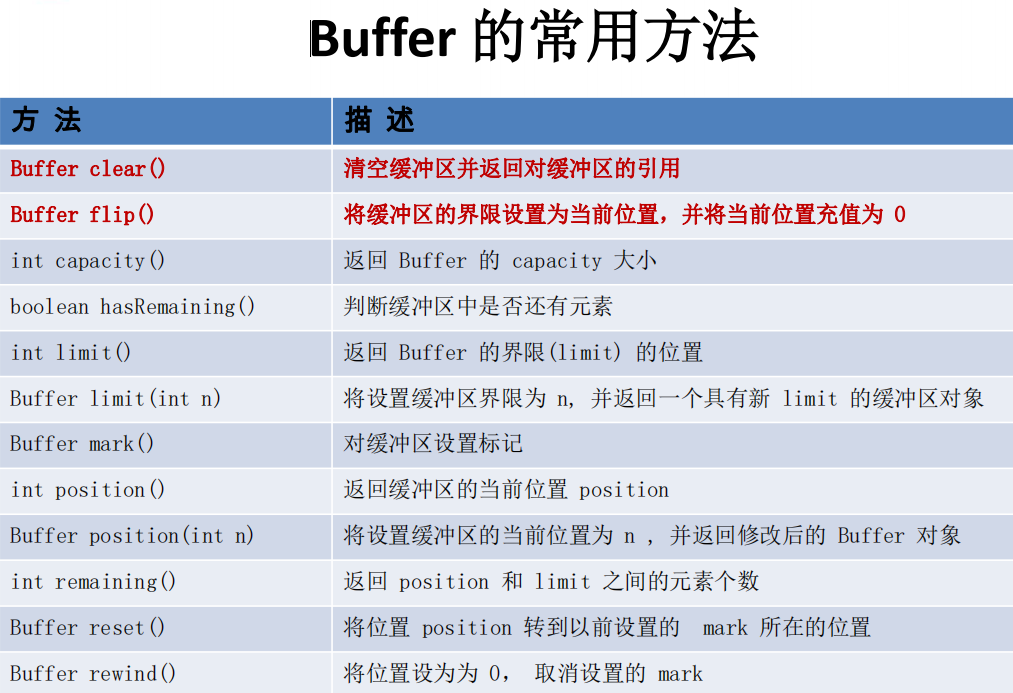
4、缓冲区数据的操作
Buffer 所有子类提供了两个用于数据操作的方法:get() 与 put() 方法
获取 Buffer 中的数据:
get() :读取单个字节
get(byte[] dst):批量读取多个字节到 dst 中
get(int index):读取指定索引位置的字节(不会移动 position)
放入数据到 Buffer 中
put(byte b):将给定单个字节写入缓冲区的当前位置
put(byte[] src):将 src 中的字节写入缓冲区的当前位置
put(int index, byte b):将指定字节写入缓冲区的索引位置(不会移动 position)
5、直接缓冲区与非直接缓冲区
1)、字节缓冲区要么是直接的,要么是非直接的。如果为直接字节缓冲区,则 Java 虚拟机会尽最大努力直接在此缓冲区上执行本机 I/O 操作。也就是说,在每次调用基础操作系统的一个本机 I/O 操作之前(或之后),
虚拟机都会尽量避免将缓冲区的内容复制到中间缓冲区中(或从中间缓冲区中复制内容)。
2)、直接字节缓冲区可以通过调用此类的 allocateDirect() 工厂方法来创建。此方法返回的缓冲区进行分配和取消分配所需成本通常高于非直接缓冲区。直接缓冲区的内容可以驻留在常规的垃圾回收堆之外,因此,它们对
应用程序的内存需求量造成的影响可能并不明显。所以,建议将直接缓冲区主要分配给那些易受基础系统的本机 I/O 操作影响的大型、持久的缓冲区。一般情况下,最好仅在直接缓冲区能在程序性能方面带来明显好
处时分配它们。
3)、直接字节缓冲区还可以通过 FileChannel 的 map() 方法 将文件区域直接映射到内存中来创建。该方法返回MappedByteBuffer 。Java 平台的实现有助于通过 JNI 从本机代码创建直接字节缓冲区。如果以上这些缓冲区
中的某个缓冲区实例指的是不可访问的内存区域,则试图访问该区域不会更改该缓冲区的内容,并且将会在访问期间或稍后的某个时间导致抛出不确定的异常。
4)、字节缓冲区是直接缓冲区还是非直接缓冲区可通过调用其 isDirect() 方法来确定。提供此方法是为了能够在性能关键型代码中执行显式缓冲区管理。

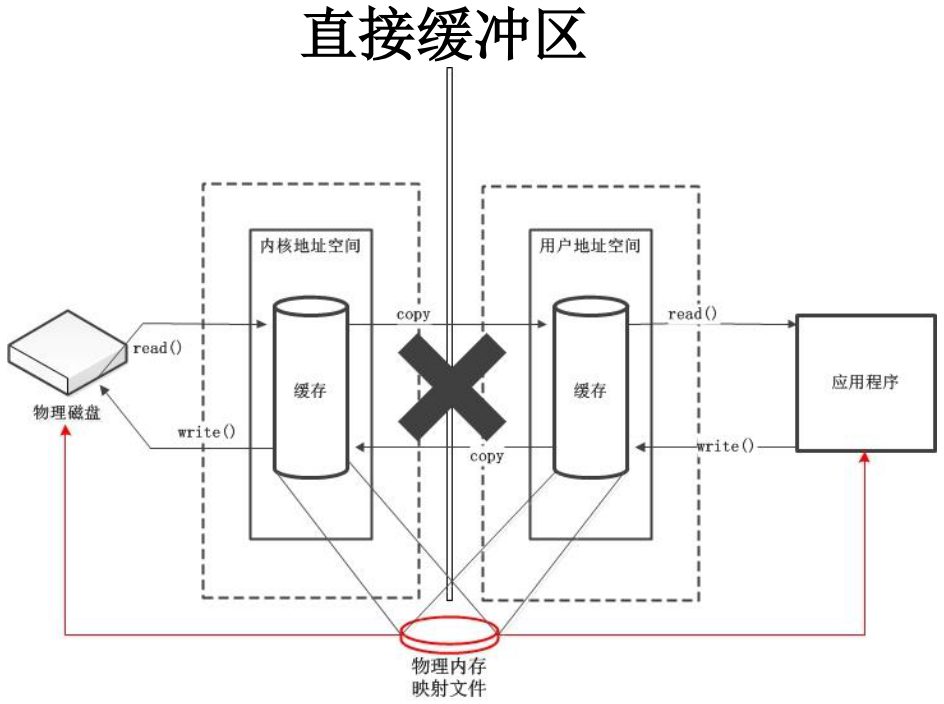
package dyh.nio; import org.junit.Test; import java.nio.ByteBuffer; /*
* 一、缓冲区(Buffer):在 Java NIO 中负责数据的存取。缓冲区就是数组。用于存储不同数据类型的数据
*
* 根据数据类型不同(boolean 除外),提供了相应类型的缓冲区:
* ByteBuffer
* CharBuffer
* ShortBuffer
* IntBuffer
* LongBuffer
* FloatBuffer
* DoubleBuffer
*
* 上述缓冲区的管理方式几乎一致,通过 allocate() 获取缓冲区
*
* 二、缓冲区存取数据的两个核心方法:
* put() : 存入数据到缓冲区中
* get() : 获取缓冲区中的数据
*
* 三、缓冲区中的四个核心属性:
* capacity : 容量,表示缓冲区中最大存储数据的容量。一旦声明不能改变。
* limit : 界限,表示缓冲区中可以操作数据的大小。(limit 后数据不能进行读写)
* position : 位置,表示缓冲区中正在操作数据的位置。
*
* mark : 标记,表示记录当前 position 的位置。可以通过 reset() 恢复到 mark 的位置
*
* 0 <= mark <= position <= limit <= capacity
*
* 四、直接缓冲区与非直接缓冲区:
* 非直接缓冲区:通过 allocate() 方法分配缓冲区,将缓冲区建立在 JVM 的内存中
* 直接缓冲区:通过 allocateDirect() 方法分配直接缓冲区,将缓冲区建立在物理内存中。可以提高效率
*/
public class TestBuffer { @Test
public void fun1(){
String str = "HelloWorld"; //1. 分配一个指定大小的缓冲区
ByteBuffer buf = ByteBuffer.allocate(1024);
System.out.println(buf.capacity());
System.out.println(buf.limit());
System.out.println(buf.position()); //2. 利用 put() 存入数据到缓冲区中
buf.put(str.getBytes());
System.out.println("-----------------put()----------------");
System.out.println(buf.capacity());
System.out.println(buf.limit());
System.out.println(buf.position()); //3. 切换读取数据模式
buf.flip();
System.out.println("-----------------flip()----------------");
System.out.println(buf.capacity());
System.out.println(buf.limit());
System.out.println(buf.position()); //4. 利用 get() 读取缓冲区中的数据
byte[] dst = new byte[buf.limit()];
buf.get(dst);
System.out.println(new String(dst, 0, dst.length));
System.out.println("-----------------get()----------------");
System.out.println(buf.capacity());
System.out.println(buf.limit());
System.out.println(buf.position()); //5. rewind() : 可重复读
buf.rewind();
System.out.println("-----------------rewind()----------------");
System.out.println(buf.position());
System.out.println(buf.limit());
System.out.println(buf.capacity()); //6. clear() : 清空缓冲区. 但是缓冲区中的数据依然存在,但是处于“被遗忘”状态
buf.clear();
System.out.println("-----------------clear()----------------");
System.out.println(buf.position());
System.out.println(buf.limit());
System.out.println(buf.capacity()); System.out.println((char)buf.get());
} @Test
public void fun2(){
String str = "abcde"; ByteBuffer buf = ByteBuffer.allocate(1024); buf.put(str.getBytes()); buf.flip(); byte[] dst = new byte[buf.limit()];
buf.get(dst, 0, 2);
System.out.println(new String(dst, 0, 2));
System.out.println(buf.position()); //mark() : 标记
buf.mark(); buf.get(dst, 2, 2);
System.out.println(new String(dst, 2, 2));
System.out.println(buf.position()); //reset() : 恢复到 mark 的位置
buf.reset();
System.out.println(buf.position()); //判断缓冲区中是否还有剩余数据
if(buf.hasRemaining()){ //获取缓冲区中可以操作的数量
System.out.println(buf.remaining());
}
} @Test
public void fun3(){
//分配直接缓冲区
ByteBuffer buf = ByteBuffer.allocateDirect(1024); System.out.println(buf.isDirect());
}
}
二、通道(Channel)
由 java.nio.channels 包定义的。Channel 表示 IO 源与目标打开的连接。Channel 类似于传统的“流”。只不过 Channel 本身不能直接访问数据,Channel 只能与Buffer 进行交互。
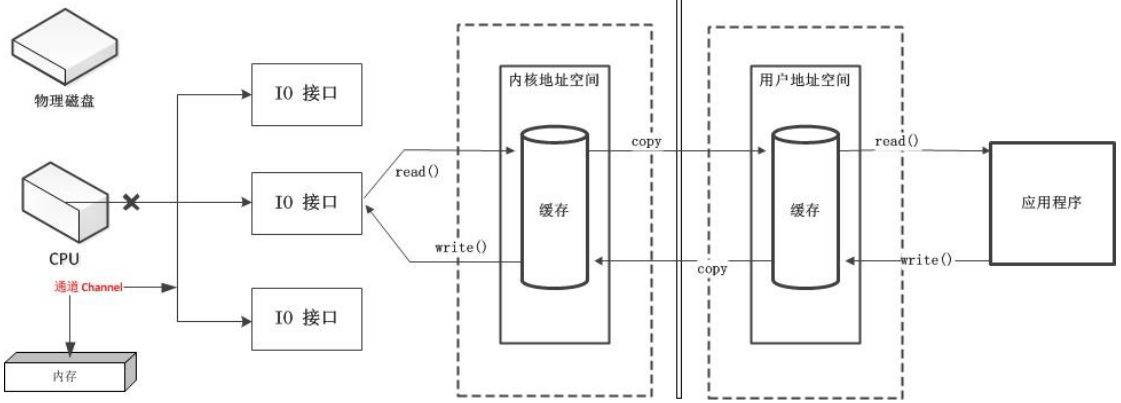
1、Java 为 Channel 接口提供的最主要实现类如下:
• FileChannel:用于读取、写入、映射和操作文件的通道。
• DatagramChannel:通过 UDP 读写网络中的数据通道。
• SocketChannel:通过 TCP 读写网络中的数据。
• ServerSocketChannel:可以监听新进来的 TCP 连接,对每一个新进来的连接都会创建一个 SocketChannel。
2、获取通道的一种方式是对支持通道的对象调用getChannel() 方法。
支持通道的类如下:
- FileInputStream
- FileOutputStream
- RandomAccessFile
- DatagramSocket
- Socket
- ServerSocket
获取通道的其他方式是使用 Files 类的静态方法 newByteChannel() 获取字节通道。或者通过通道的静态方法 open() 打开并返回指定通。
3、分散和聚集
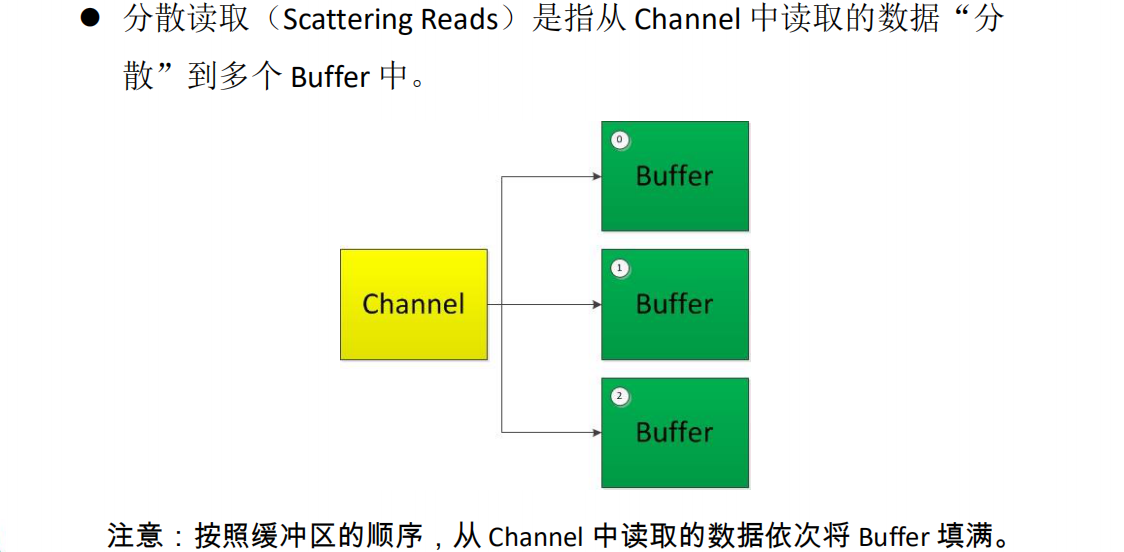

4、通道的常用方法
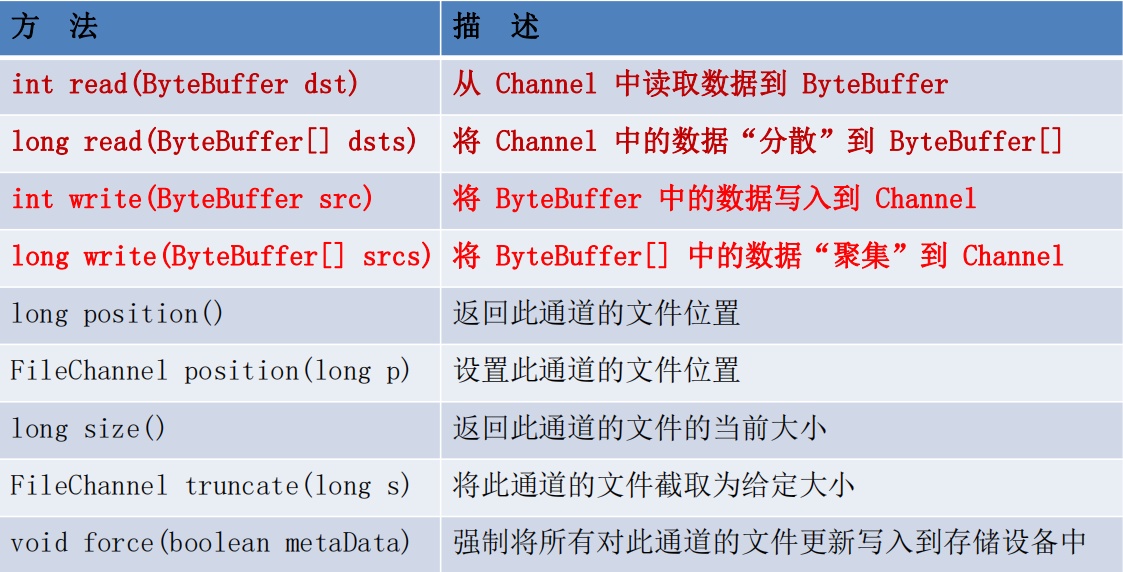
package dyh.nio; import org.junit.Test; import java.io.*;
import java.nio.ByteBuffer;
import java.nio.CharBuffer;
import java.nio.MappedByteBuffer;
import java.nio.channels.FileChannel;
import java.nio.charset.Charset;
import java.nio.charset.CharsetDecoder;
import java.nio.charset.CharsetEncoder;
import java.nio.file.Paths;
import java.nio.file.StandardOpenOption;
import java.util.SortedMap; /*
* 一、通道(Channel):用于源节点与目标节点的连接。在 Java NIO 中负责缓冲区中数据的传输。Channel 本身不存储数据,因此需要配合缓冲区进行传输。
*
* 二、通道的主要实现类
* java.nio.channels.Channel 接口:
* |--FileChannel
* |--SocketChannel
* |--ServerSocketChannel
* |--DatagramChannel
*
* 三、获取通道
* 1. Java 针对支持通道的类提供了 getChannel() 方法
* 本地 IO:
* FileInputStream/FileOutputStream
* RandomAccessFile
*
* 网络IO:
* Socket
* ServerSocket
* DatagramSocket
*
* 2. 在 JDK 1.7 中的 NIO.2 针对各个通道提供了静态方法 open()
* 3. 在 JDK 1.7 中的 NIO.2 的 Files 工具类的 newByteChannel()
*
* 四、通道之间的数据传输
* transferFrom()
* transferTo()
*
* 五、分散(Scatter)与聚集(Gather)
* 分散读取(Scattering Reads):将通道中的数据分散到多个缓冲区中
* 聚集写入(Gathering Writes):将多个缓冲区中的数据聚集到通道中
*
* 六、字符集:Charset
* 编码:字符串 -> 字节数组
* 解码:字节数组 -> 字符串
*
*/
public class TestChannel { //利用通道完成文件的复制(非直接缓冲区)
@Test
public void fun1() {
FileInputStream fi = null;
FileOutputStream fo = null; FileChannel fiChannel = null;
FileChannel foChannel = null;
try {
fi = new FileInputStream("1.jpg");
fo = new FileOutputStream("2.jpg");
//1、获取通道
fiChannel = fi.getChannel();
foChannel = fo.getChannel(); //2、指定缓冲区大小
ByteBuffer allocate = ByteBuffer.allocate(1024); //3、把通道中的数据存入缓冲区
while (fiChannel.read(allocate) != -1){
allocate.flip();//切换读取数据的模式
foChannel.write(allocate);//④将缓冲区中的数据写入通道中
allocate.clear();//清空缓冲区
}
} catch (Exception e) {
e.printStackTrace();
}finally {
if (fi != null){
try {
fi.close();
} catch (IOException e) {
e.printStackTrace();
}
}
if (fo != null){
try {
fo.close();
} catch (IOException e) {
e.printStackTrace();
}
}
if (fiChannel != null){
try {
fiChannel.close();
} catch (IOException e) {
e.printStackTrace();
}
}
if (foChannel != null){
try {
foChannel.close();
} catch (IOException e) {
e.printStackTrace();
}
}
}
} //使用直接缓冲区完成文件的复制(内存映射文件)
@Test
public void fun2() throws Exception {
//测试速度
long start = System.currentTimeMillis();
FileChannel fiC = FileChannel.open(Paths.get("1.jpg"), StandardOpenOption.READ);
FileChannel foC = FileChannel.open(Paths.get("3.jpg"), StandardOpenOption.READ, StandardOpenOption.WRITE, StandardOpenOption.CREATE_NEW); //内存映射文件
MappedByteBuffer mi = fiC.map(FileChannel.MapMode.READ_ONLY, 0, fiC.size());
MappedByteBuffer mo = foC.map(FileChannel.MapMode.READ_WRITE, 0, fiC.size()); byte[] b = new byte[mi.limit()];
mi.get(b);
mo.put(b); fiC.close();
foC.close(); long end = System.currentTimeMillis();
System.out.println("耗费时间为:" + (end - start));
} //通道间的数据传输
@Test
public void fun3() throws IOException { FileChannel fiC = FileChannel.open(Paths.get("1.jpg"), StandardOpenOption.READ);
FileChannel foC = FileChannel.open(Paths.get("4.jpg"), StandardOpenOption.READ, StandardOpenOption.WRITE, StandardOpenOption.CREATE_NEW); fiC.transferTo(0, fiC.size(), foC);
foC.transferFrom(fiC,0,fiC.size());
fiC.close();
foC.close();
} //分散读取和聚集写入
@Test
public void fun4() throws Exception {
RandomAccessFile raf1 = new RandomAccessFile("1.txt", "rw"); //1. 获取通道
FileChannel channel1 = raf1.getChannel(); //2. 分配指定大小的缓冲区
ByteBuffer buf1 = ByteBuffer.allocate(100);
ByteBuffer buf2 = ByteBuffer.allocate(1024); //3. 分散读取
ByteBuffer[] bufs = {buf1, buf2};
channel1.read(bufs); for (ByteBuffer byteBuffer : bufs) {
byteBuffer.flip();
}
//测试分散读取
System.out.println(new String(bufs[0].array(), 0, bufs[0].limit()));
System.out.println("-----------------");
System.out.println(new String(bufs[1].array(), 0, bufs[1].limit())); //4. 聚集写入
RandomAccessFile raf2 = new RandomAccessFile("2.txt", "rw");
FileChannel channel2 = raf2.getChannel(); channel2.write(bufs);
} //字符集
@Test
public void fun5(){
SortedMap<String, Charset> cm = Charset.availableCharsets();
for (String s : cm.keySet()) {
//遍历支持的字符集
System.out.println(s);
}
} @Test
public void fun6() throws Exception {
Charset ct = Charset.forName("GBK"); //获取编码器
CharsetEncoder ce = ct.newEncoder(); //获取解码器
CharsetDecoder cd = ct.newDecoder(); CharBuffer cBuf1 = CharBuffer.allocate(1024);
cBuf1.put("你好世界");
cBuf1.flip(); //进行编码
ByteBuffer bBuf = ce.encode(cBuf1);
for (int i = 0; i < 8; i++){
System.out.println(bBuf.get());
} //进行解码
bBuf.flip();
CharBuffer cBuf2 = cd.decode(bBuf);
System.out.println(cBuf2.toString()); System.out.println("-------------使用UTF-8进行解码-----------------");
Charset cu = Charset.forName("UTF-8"); bBuf.flip();
CharBuffer cuDe = cu.decode(bBuf);
System.out.println(cuDe.toString());
}
}
三、NIO网络通信
1、阻塞与非阻塞
传统的 IO 流都是阻塞式的。也就是说,当一个线程调用 read() 或 write() 时,该线程被阻塞,直到有一些数据被读取或写入,该线程在此期间不能执行其他任务。因此,在完成网络通信进行 IO 操作时,由于线程会阻塞,所以服务器端必须为每个客户端都提供一个独立的线程进行处理,当服务器端需要处理大量客户端时,性能急剧下降。
Java NIO 是非阻塞模式的。当线程从某通道进行读写数据时,若没有数据可用时,该线程可以进行其他任务。线程通常将非阻塞 IO 的空闲时间用于在其他通道上执行 IO 操作,所以单独的线程可以管理多个输入和输出通道。因此,NIO 可以让服务器端使用一个或有限几个线程来同时处理连接到服务器端的所有客户端。
2、选择器
选择器(Selector) 是 SelectableChannle 对象的多路复用器,Selector 可以同时监控多个 SelectableChannel 的 IO 状况,也就是说,利用 Selector 可使一个单独的线程管理多个 Channel。Selector 是非阻塞 IO 的核。
选择器的应用:
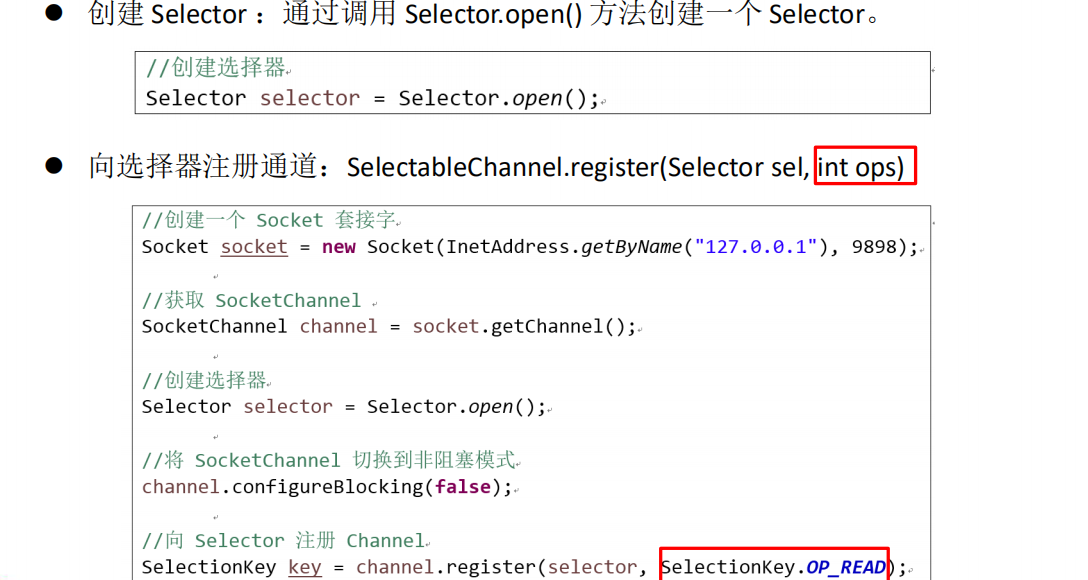

SelectionKey:
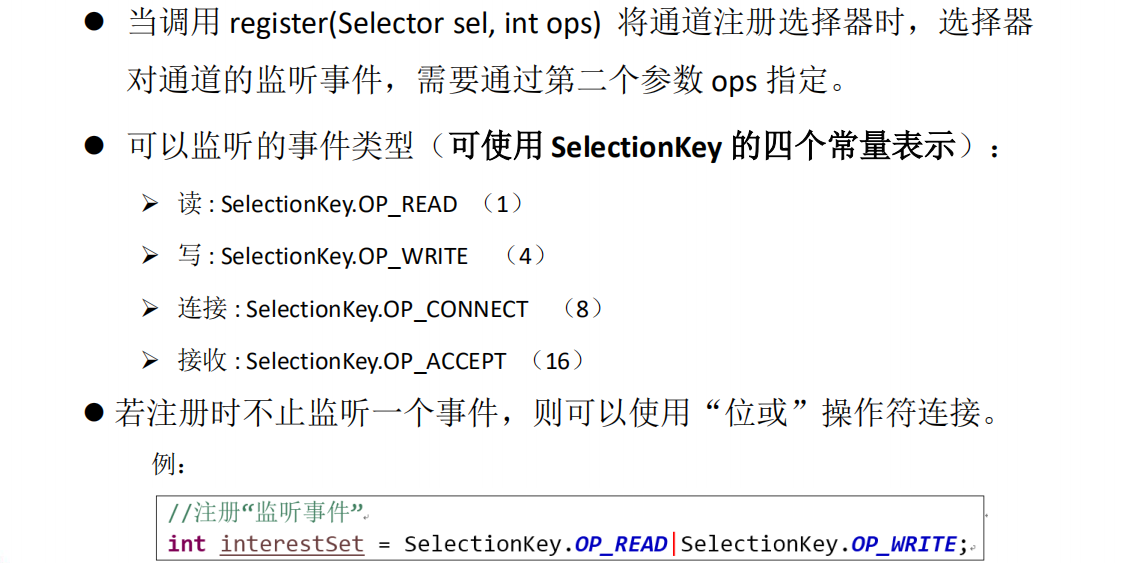
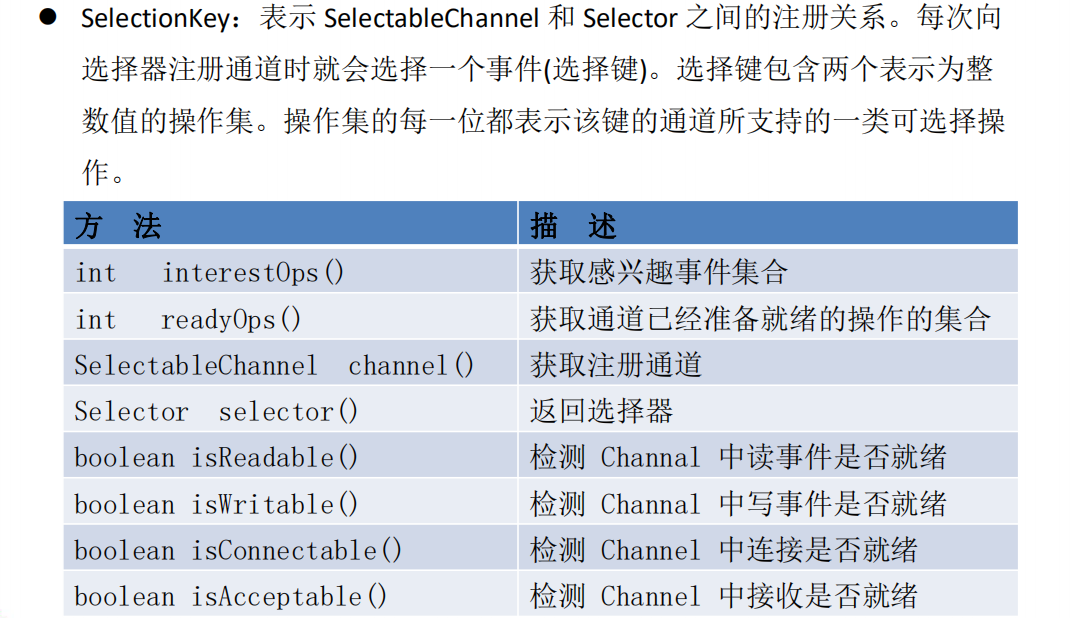
Selector的常用方法:

3、阻塞式NIO
package dyh.nioNet; import org.junit.Test; import java.io.IOException;
import java.net.InetSocketAddress;
import java.nio.ByteBuffer;
import java.nio.channels.FileChannel;
import java.nio.channels.ServerSocketChannel;
import java.nio.channels.SocketChannel;
import java.nio.file.Paths;
import java.nio.file.StandardOpenOption; /*
* 一、使用 NIO 完成网络通信的三个核心:
*
* 1. 通道(Channel):负责连接
*
* java.nio.channels.Channel 接口:
* |--SelectableChannel
* |--SocketChannel
* |--ServerSocketChannel
* |--DatagramChannel
*
* |--Pipe.SinkChannel
* |--Pipe.SourceChannel
*
* 2. 缓冲区(Buffer):负责数据的存取
*
* 3. 选择器(Selector):是 SelectableChannel 的多路复用器。用于监控 SelectableChannel 的 IO 状况
*
*/
public class TestBlockingNIO { @Test
public void client() throws IOException {
//获取通道
SocketChannel open = SocketChannel.open(new InetSocketAddress("127.0.0.1", 9898));
FileChannel fc = FileChannel.open(Paths.get("1.jpg"), StandardOpenOption.READ); //分配缓冲器大小
ByteBuffer allocate = ByteBuffer.allocate(1024); //读取文件,并发送至客户端
while (fc.read(allocate) != -1){
allocate.flip();
open.write(allocate);
allocate.clear();
} //关闭
open.close();
fc.close(); } @Test
public void server() throws IOException {
//获取通道
ServerSocketChannel open = ServerSocketChannel.open();
FileChannel fc = FileChannel.open(Paths.get("5.jpg"), StandardOpenOption.WRITE, StandardOpenOption.CREATE); //绑定连接
ServerSocketChannel bind = open.bind(new InetSocketAddress(9898)); //获取客户端的连接通道
SocketChannel accept = bind.accept(); //分配缓冲器大小
ByteBuffer allocate = ByteBuffer.allocate(1024); //读取获取的数据,并保存到本地
while (accept.read(allocate) != -1){
allocate.flip();
fc.write(allocate);
allocate.clear();
} open.close();
fc.close();
accept.close();
}
}
import java.io.IOException;
import java.net.InetSocketAddress;
import java.nio.ByteBuffer;
import java.nio.channels.FileChannel;
import java.nio.channels.ServerSocketChannel;
import java.nio.channels.SocketChannel;
import java.nio.file.Paths;
import java.nio.file.StandardOpenOption; import org.junit.Test; public class TestBlockingNIO2 { //客户端
@Test
public void client() throws IOException{
SocketChannel sChannel = SocketChannel.open(new InetSocketAddress("127.0.0.1", 9898)); FileChannel inChannel = FileChannel.open(Paths.get("1.jpg"), StandardOpenOption.READ); ByteBuffer buf = ByteBuffer.allocate(1024); while(inChannel.read(buf) != -1){
buf.flip();
sChannel.write(buf);
buf.clear();
} sChannel.shutdownOutput(); //接收服务端的反馈
int len = 0;
while((len = sChannel.read(buf)) != -1){
buf.flip();
System.out.println(new String(buf.array(), 0, len));
buf.clear();
} inChannel.close();
sChannel.close();
} //服务端
@Test
public void server() throws IOException{
ServerSocketChannel ssChannel = ServerSocketChannel.open(); FileChannel outChannel = FileChannel.open(Paths.get("2.jpg"), StandardOpenOption.WRITE, StandardOpenOption.CREATE); ssChannel.bind(new InetSocketAddress(9898)); SocketChannel sChannel = ssChannel.accept(); ByteBuffer buf = ByteBuffer.allocate(1024); while(sChannel.read(buf) != -1){
buf.flip();
outChannel.write(buf);
buf.clear();
} //发送反馈给客户端
buf.put("服务端接收数据成功".getBytes());
buf.flip();
sChannel.write(buf); sChannel.close();
outChannel.close();
ssChannel.close();
} }
4、非阻塞式NIO
import java.io.IOException;
import java.net.InetSocketAddress;
import java.nio.ByteBuffer;
import java.nio.channels.SelectionKey;
import java.nio.channels.Selector;
import java.nio.channels.ServerSocketChannel;
import java.nio.channels.SocketChannel;
import java.util.Date;
import java.util.Iterator;
import java.util.Scanner; import org.junit.Test; /*
* 一、使用 NIO 完成网络通信的三个核心:
*
* 1. 通道(Channel):负责连接
*
* java.nio.channels.Channel 接口:
* |--SelectableChannel
* |--SocketChannel
* |--ServerSocketChannel
* |--DatagramChannel
*
* |--Pipe.SinkChannel
* |--Pipe.SourceChannel
*
* 2. 缓冲区(Buffer):负责数据的存取
*
* 3. 选择器(Selector):是 SelectableChannel 的多路复用器。用于监控 SelectableChannel 的 IO 状况
*
*/
public class TestNonBlockingNIO { //客户端
@Test
public void client() throws IOException{
//1. 获取通道
SocketChannel sChannel = SocketChannel.open(new InetSocketAddress("127.0.0.1", 9898)); //2. 切换非阻塞模式
sChannel.configureBlocking(false); //3. 分配指定大小的缓冲区
ByteBuffer buf = ByteBuffer.allocate(1024); //4. 发送数据给服务端
Scanner scan = new Scanner(System.in); while(scan.hasNext()){
String str = scan.next();
buf.put((new Date().toString() + "\n" + str).getBytes());
buf.flip();
sChannel.write(buf);
buf.clear();
} //5. 关闭通道
sChannel.close();
} //服务端
@Test
public void server() throws IOException{
//1. 获取通道
ServerSocketChannel ssChannel = ServerSocketChannel.open(); //2. 切换非阻塞模式
ssChannel.configureBlocking(false); //3. 绑定连接
ssChannel.bind(new InetSocketAddress(9898)); //4. 获取选择器
Selector selector = Selector.open(); //5. 将通道注册到选择器上, 并且指定“监听接收事件”
ssChannel.register(selector, SelectionKey.OP_ACCEPT); //6. 轮询式的获取选择器上已经“准备就绪”的事件
while(selector.select() > 0){ //7. 获取当前选择器中所有注册的“选择键(已就绪的监听事件)”
Iterator<SelectionKey> it = selector.selectedKeys().iterator(); while(it.hasNext()){
//8. 获取准备“就绪”的是事件
SelectionKey sk = it.next(); //9. 判断具体是什么事件准备就绪
if(sk.isAcceptable()){
//10. 若“接收就绪”,获取客户端连接
SocketChannel sChannel = ssChannel.accept(); //11. 切换非阻塞模式
sChannel.configureBlocking(false); //12. 将该通道注册到选择器上
sChannel.register(selector, SelectionKey.OP_READ);
}else if(sk.isReadable()){
//13. 获取当前选择器上“读就绪”状态的通道
SocketChannel sChannel = (SocketChannel) sk.channel(); //14. 读取数据
ByteBuffer buf = ByteBuffer.allocate(1024); int len = 0;
while((len = sChannel.read(buf)) > 0 ){
buf.flip();
System.out.println(new String(buf.array(), 0, len));
buf.clear();
}
} //15. 取消选择键 SelectionKey
it.remove();
}
}
}
}
import java.io.IOException;
import java.net.InetSocketAddress;
import java.nio.ByteBuffer;
import java.nio.channels.DatagramChannel;
import java.nio.channels.SelectionKey;
import java.nio.channels.Selector;
import java.util.Date;
import java.util.Iterator;
import java.util.Scanner; import org.junit.Test; public class TestNonBlockingNIO2 { @Test
public void send() throws IOException{
DatagramChannel dc = DatagramChannel.open(); dc.configureBlocking(false); ByteBuffer buf = ByteBuffer.allocate(1024); Scanner scan = new Scanner(System.in); while(scan.hasNext()){
String str = scan.next();
buf.put((new Date().toString() + ":\n" + str).getBytes());
buf.flip();
dc.send(buf, new InetSocketAddress("127.0.0.1", 9898));
buf.clear();
} dc.close();
} @Test
public void receive() throws IOException{
DatagramChannel dc = DatagramChannel.open(); dc.configureBlocking(false); dc.bind(new InetSocketAddress(9898)); Selector selector = Selector.open(); dc.register(selector, SelectionKey.OP_READ); while(selector.select() > 0){
Iterator<SelectionKey> it = selector.selectedKeys().iterator(); while(it.hasNext()){
SelectionKey sk = it.next(); if(sk.isReadable()){
ByteBuffer buf = ByteBuffer.allocate(1024); dc.receive(buf);
buf.flip();
System.out.println(new String(buf.array(), 0, buf.limit()));
buf.clear();
}
} it.remove();
}
} }
5、管道
Java NIO 管道是2个线程之间的单向数据连接。Pipe有一个source通道和一个sink通道。数据会被写到sink通道,从source通道读取。

import java.io.IOException;
import java.nio.ByteBuffer;
import java.nio.channels.Pipe; import org.junit.Test; public class TestPipe { @Test
public void test1() throws IOException{
//1. 获取管道
Pipe pipe = Pipe.open(); //2. 将缓冲区中的数据写入管道
ByteBuffer buf = ByteBuffer.allocate(1024); Pipe.SinkChannel sinkChannel = pipe.sink();
buf.put("通过单向管道发送数据".getBytes());
buf.flip();
sinkChannel.write(buf); //3. 读取缓冲区中的数据
Pipe.SourceChannel sourceChannel = pipe.source();
buf.flip();
int len = sourceChannel.read(buf);
System.out.println(new String(buf.array(), 0, len)); sourceChannel.close();
sinkChannel.close();
} }
四、NIO2
随着 JDK 7 的发布,Java对NIO进行了极大的扩展,增强了对文件处理和文件系统特性的支持,以至于我们称他们为 NIO.2。因为 NIO 提供的一些功能,NIO已经成为文件处理中越来越重要的部分。
1、Path与Paths
java.nio.file.Path 接口代表一个平台无关的平台路径,描述了目录结构中文件的位置。
Paths 提供的 get() 方法用来获取 Path 对象:
Path get(String first, String … more) : 用于将多个字符串串连成路径。
Path 常用方法:
boolean endsWith(String path) : 判断是否以 path 路径结束
boolean startsWith(String path) : 判断是否以 path 路径开始
boolean isAbsolute() : 判断是否是绝对路径
Path getFileName() : 返回与调用 Path 对象关联的文件名
Path getName(int idx) : 返回的指定索引位置 idx 的路径名称
int getNameCount() : 返回Path 根目录后面元素的数量
Path getParent() :返回Path对象包含整个路径,不包含 Path 对象指定的文件路径
Path getRoot() :返回调用 Path 对象的根路径
Path resolve(Path p) :将相对路径解析为绝对路径
Path toAbsolutePath() : 作为绝对路径返回调用 Path 对象
String toString() : 返回调用 Path 对象的字符串表示
2、Files类
java.nio.file.Files 用于操作文件或目录的工具类。
Files常用方法:
Path copy(Path src, Path dest, CopyOption … how) : 文件的复制
Path createDirectory(Path path, FileAttribute<?> … attr) : 创建一个目录
Path createFile(Path path, FileAttribute<?> … arr) : 创建一个文件
void delete(Path path) : 删除一个文件
Path move(Path src, Path dest, CopyOption…how) : 将 src 移动到 dest 位置
long size(Path path) : 返回 path 指定文件的大小
Files常用方法:用于判断
boolean exists(Path path, LinkOption … opts) : 判断文件是否存在
boolean isDirectory(Path path, LinkOption … opts) : 判断是否是目录
boolean isExecutable(Path path) : 判断是否是可执行文件
boolean isHidden(Path path) : 判断是否是隐藏文件
boolean isReadable(Path path) : 判断文件是否可读
boolean isWritable(Path path) : 判断文件是否可写
boolean notExists(Path path, LinkOption … opts) : 判断文件是否不存在
public static <A extends BasicFileAttributes> A readAttributes(Path path,Class<A> type,LinkOption... options) : 获取与 path 指定的文件相关联的属性。
Files常用方法:用于操作内容
SeekableByteChannel newByteChannel(Path path, OpenOption…how) : 获取与指定文件的连接,how 指定打开方式。
DirectoryStream newDirectoryStream(Path path) : 打开 path 指定的目录
InputStream newInputStream(Path path, OpenOption…how):获取 InputStream 对象
OutputStream newOutputStream(Path path, OpenOption…how) : 获取 OutputStream 对象
3、自动资源管理
Java 7 增加了一个新特性,该特性提供了另外一种管理资源的方式,这种方式能自动关闭文件。这个特性有时被称为自动资源管理(Automatic Resource Management, ARM), 该特性以 try 语句的扩展版为基础。自动资源管理主要用于,当不再需要文件(或其他资源)时,可以防止无意中忘记释放它们。
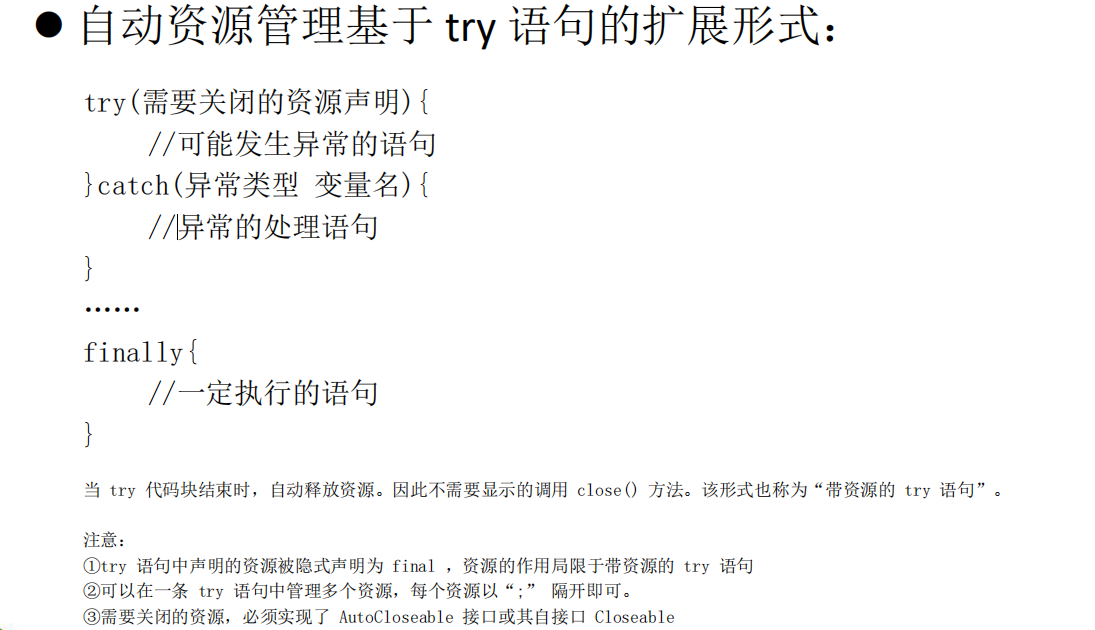
package com.atguigu.nio; import java.io.IOException;
import java.nio.ByteBuffer;
import java.nio.channels.FileChannel;
import java.nio.channels.SeekableByteChannel;
import java.nio.file.DirectoryStream;
import java.nio.file.Files;
import java.nio.file.LinkOption;
import java.nio.file.Path;
import java.nio.file.Paths;
import java.nio.file.StandardCopyOption;
import java.nio.file.StandardOpenOption;
import java.nio.file.attribute.BasicFileAttributes;
import java.nio.file.attribute.DosFileAttributeView; import org.junit.Test; public class TestNIO_2 { //自动资源管理:自动关闭实现 AutoCloseable 接口的资源
@Test
public void test8(){
try(FileChannel inChannel = FileChannel.open(Paths.get("1.jpg"), StandardOpenOption.READ);
FileChannel outChannel = FileChannel.open(Paths.get("2.jpg"), StandardOpenOption.WRITE, StandardOpenOption.CREATE)){ ByteBuffer buf = ByteBuffer.allocate(1024);
inChannel.read(buf); }catch(IOException e){ }
} /*
Files常用方法:用于操作内容
SeekableByteChannel newByteChannel(Path path, OpenOption…how) : 获取与指定文件的连接,how 指定打开方式。
DirectoryStream newDirectoryStream(Path path) : 打开 path 指定的目录
InputStream newInputStream(Path path, OpenOption…how):获取 InputStream 对象
OutputStream newOutputStream(Path path, OpenOption…how) : 获取 OutputStream 对象
*/
@Test
public void test7() throws IOException{
SeekableByteChannel newByteChannel = Files.newByteChannel(Paths.get("1.jpg"), StandardOpenOption.READ); DirectoryStream<Path> newDirectoryStream = Files.newDirectoryStream(Paths.get("e:/")); for (Path path : newDirectoryStream) {
System.out.println(path);
}
} /*
Files常用方法:用于判断
boolean exists(Path path, LinkOption … opts) : 判断文件是否存在
boolean isDirectory(Path path, LinkOption … opts) : 判断是否是目录
boolean isExecutable(Path path) : 判断是否是可执行文件
boolean isHidden(Path path) : 判断是否是隐藏文件
boolean isReadable(Path path) : 判断文件是否可读
boolean isWritable(Path path) : 判断文件是否可写
boolean notExists(Path path, LinkOption … opts) : 判断文件是否不存在
public static <A extends BasicFileAttributes> A readAttributes(Path path,Class<A> type,LinkOption... options) : 获取与 path 指定的文件相关联的属性。
*/
@Test
public void test6() throws IOException{
Path path = Paths.get("e:/nio/hello7.txt");
// System.out.println(Files.exists(path, LinkOption.NOFOLLOW_LINKS)); BasicFileAttributes readAttributes = Files.readAttributes(path, BasicFileAttributes.class, LinkOption.NOFOLLOW_LINKS);
System.out.println(readAttributes.creationTime());
System.out.println(readAttributes.lastModifiedTime()); DosFileAttributeView fileAttributeView = Files.getFileAttributeView(path, DosFileAttributeView.class, LinkOption.NOFOLLOW_LINKS); fileAttributeView.setHidden(false);
} /*
Files常用方法:
Path copy(Path src, Path dest, CopyOption … how) : 文件的复制
Path createDirectory(Path path, FileAttribute<?> … attr) : 创建一个目录
Path createFile(Path path, FileAttribute<?> … arr) : 创建一个文件
void delete(Path path) : 删除一个文件
Path move(Path src, Path dest, CopyOption…how) : 将 src 移动到 dest 位置
long size(Path path) : 返回 path 指定文件的大小
*/
@Test
public void test5() throws IOException{
Path path1 = Paths.get("e:/nio/hello2.txt");
Path path2 = Paths.get("e:/nio/hello7.txt"); System.out.println(Files.size(path2)); // Files.move(path1, path2, StandardCopyOption.ATOMIC_MOVE);
} @Test
public void test4() throws IOException{
Path dir = Paths.get("e:/nio/nio2");
// Files.createDirectory(dir); Path file = Paths.get("e:/nio/nio2/hello3.txt");
// Files.createFile(file); Files.deleteIfExists(file);
} @Test
public void test3() throws IOException{
Path path1 = Paths.get("e:/nio/hello.txt");
Path path2 = Paths.get("e:/nio/hello2.txt"); Files.copy(path1, path2, StandardCopyOption.REPLACE_EXISTING);
} /*
Paths 提供的 get() 方法用来获取 Path 对象:
Path get(String first, String … more) : 用于将多个字符串串连成路径。
Path 常用方法:
boolean endsWith(String path) : 判断是否以 path 路径结束
boolean startsWith(String path) : 判断是否以 path 路径开始
boolean isAbsolute() : 判断是否是绝对路径
Path getFileName() : 返回与调用 Path 对象关联的文件名
Path getName(int idx) : 返回的指定索引位置 idx 的路径名称
int getNameCount() : 返回Path 根目录后面元素的数量
Path getParent() :返回Path对象包含整个路径,不包含 Path 对象指定的文件路径
Path getRoot() :返回调用 Path 对象的根路径
Path resolve(Path p) :将相对路径解析为绝对路径
Path toAbsolutePath() : 作为绝对路径返回调用 Path 对象
String toString() : 返回调用 Path 对象的字符串表示形式
*/
@Test
public void test2(){
Path path = Paths.get("e:/nio/hello.txt"); System.out.println(path.getParent());
System.out.println(path.getRoot()); // Path newPath = path.resolve("e:/hello.txt");
// System.out.println(newPath); Path path2 = Paths.get("1.jpg");
Path newPath = path2.toAbsolutePath();
System.out.println(newPath); System.out.println(path.toString());
} @Test
public void test1(){
Path path = Paths.get("e:/", "nio/hello.txt"); System.out.println(path.endsWith("hello.txt"));
System.out.println(path.startsWith("e:/")); System.out.println(path.isAbsolute());
System.out.println(path.getFileName()); for (int i = 0; i < path.getNameCount(); i++) {
System.out.println(path.getName(i));
}
}
}
Java基础之NIO的更多相关文章
- java 基础之--nio 网络编程
在传统的Java 网络编程中,对于客户端的每次连接,对于服务器来说,都要创建一个新的线程与客户端进行通讯,这种频繁的线程的创建,对于服务器来说,是一种巨大的损耗,在Java 1.4 引入Java ni ...
- Java后端工程师必备书单(从Java基础到分布式)
Java开发工程师一般负责后端开发,当然也有专门做Java Web的工程师,但是随着前后端的分离,越来越多的Java工程师需要往大后端方向发展. 今天我们就来介绍一下Java后端开发者的书单. 首先要 ...
- java基础-网络编程(Socket)技术选型入门之NIO技术
java基础-网络编程(Socket)技术选型入门之NIO技术 作者:尹正杰 版权声明:原创作品,谢绝转载!否则将追究法律责任. 一.传统的网络编程 1>.编写socket通信的MyServer ...
- JAVA基础(10)——IO、NIO
转载:http://blog.csdn.net/weitry/article/details/52964948 JAVA基础系列规划: JAVA基础(1)——基本概念 JAVA基础(2)——数据类型 ...
- Java基础知识强化之IO流笔记72:NIO之 NIO核心组件(NIO使用代码示例)
1.Java NIO 由以下几个核心部分组成: Channels(通道) Buffers(缓冲区) Selectors(选择器) 虽然Java NIO 中除此之外还有很多类和组件,Channel,Bu ...
- Java中的NIO基础知识
上一篇介绍了五种NIO模型,本篇将介绍Java中的NIO类库,为学习netty做好铺垫 Java NIO 由3个核心组成,分别是Channels,Buffers,Selectors.本文主要介绍着三个 ...
- [Java面经]干货整理, Java面试题(覆盖Java基础,Java高级,JavaEE,数据库,设计模式等)
如若转载请注明出处: http://www.cnblogs.com/wang-meng/p/5898837.html 谢谢.上一篇发了一个找工作的面经, 找工作不宜, 希望这一篇的内容能够帮助到大 ...
- 万能的林萧说:一篇文章教会你,如何做到招聘要求中的“要有扎实的Java基础”。
来历 本文来自于一次和群里猿友的交流,具体的情况且听LZ慢慢道来. 一日,LZ在群里发话,"招人啦." 然某群友曰,"群主,俺想去." LZ回之,"你 ...
- java基础-java核心知识库
本人从事java开发6年左右,主要从事互联网相关的开发,目前还是奋战在一线的码农,痛并快乐着.受互联网产品热潮的影响,关注高性能低成本架构,互联网开发框架,以下是我认为作为一个资深java程序员应该掌 ...
随机推荐
- python的常用魔法方法详细总结
构造和初始化 __init__我们很熟悉了,它在对象初始化的时候调用,我们一般将它理解为"构造函数". 实际上, 当我们调用x = SomeClass()的时候调用,__init_ ...
- 【题解】[BalticOI 2014]friends
题目链接:http://www.lydsy.com/JudgeOnline/problem.php?id=3916 (BZOJ3916) 由题意可知 \(N\) 得为奇数,\(S\) 才存在,所以先特 ...
- 小技巧:如何快速开启一个静态 HTTP 服务?
静态 HTTP 服务的几个用途: 静态网页的 HTTP 服务,以访问浏览 如:生成的文档.博客等 公开文件的 HTTP 服务,以访问下载 如:分享的文档.安装包等 以下会介绍目前我了解的方式中,最推荐 ...
- express高效入门教程(4)
4.静态文件 4.1.普通处理静态文件的方法 在./views/index.html文件中去引入另一个css文件index.css,index.css文件放在public/css目录下,目录结构是这样 ...
- 【Spring注解驱动开发】如何使用@Value注解为bean的属性赋值,我们一起吊打面试官!
写在前面 在之前的文章中,我们探讨了如何向Spring的IOC容器中注册bean组件,讲解了有关bean组件的生命周期的知识.今天,我们就来一起聊聊@Value注解的用法. 项目工程源码已经提交到Gi ...
- 缓存数据库之redis
NoSQL(NoSQL = Not Only SQL ),意即“不仅仅是SQL”,泛指非关系型的数据库,NoSQL数据库的产生就是为了解决大规模数据集合多重数据种类带来的挑战,尤其是大数据应用难题 N ...
- java语言基础(六)_String类_static_Arrays类_Math类
String类 1. 使用 java.lang.String类代表字符串.lang包含的包不用特意引用,即默认已经引用了. API当中说:Java 程序中的所有字符串字面值(如 "abc&q ...
- linux新用户(组)的那些事
linux新用户(组)的那些事 创建新用户 groupadd bigdata //添加新用户组bigdata useradd -g bigdata es //-g:为用户组添加新用户 passwd ...
- C++的基本输入输出
参考:http://www.runoob.com/cplusplus/cpp-basic-input-output.html
- 线下---复习day04---作业
1 学的不好的同学:用ajax提交一个json格式数据,返回一个json格式数据,console.log打印出来 2 通过ajax上传一个文件并保存起来,前端接收到,弹窗说上传成功 urls.py f ...
